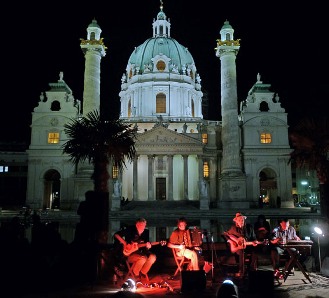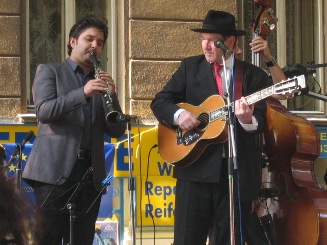
Vienna
Festivals
- Mar: Akkordeonfestival
- Apr: Balkanfever-Festival
- Jun: Jazzfest Wien
- Aug: Afrika-Tage Wien
- Nov: KlezMORE Festival
- Dec: Adventskalender
Selected Venues
Sessions, Concerts, ...

Vienna - a cultural capital, a musical wonder! It's a cliché! But is it also true beyond the likes of Schubert, Strauss and Schönberg? At least, the metropolis on the beautiful blue Danube is the only Austrian town having a noteworthy folk, world and roots music scene.
Vienna and Music - for most people this means the overcoming of the Italian Baroque, beginning in the late 18th century when the Mozarts and Beethovens were exiles on the Emperial court. More indigenous was the Viennese waltz introduced by the Strauss dynasty in the 19th century.
Already in the Middle Ages, minnesingers such as Walther von der Vogelweide, Neidhart von Reuental and Ulrich von Lichtenstein were guests of the Babenberger dukes in Vienna and sang praises of beautiful women, excellent wine and exquisit food. A fresco at Tuchlauben 19 in the inner city displays comical incidents in the life of Neidhart von Reuental.
Just around the corner, the popular folk character of Der Liebe Augustin sits as a puppet in the basement of the Griechenbeisl on Fleischmarkt. There is a popular folk song from around 1800. Legend has it that the Augustin in question had been a bagpiper and busker who drunkenly fell into a mass grave during the black death of 1679. Though he climbed out of the pit the next morning and lived happily ever after. A statue had been erected in 1908, which unfortunatly disappeared during Word World II. There is now a marker saying: Escaped from the black plague, the brown took me!
It is just but a rumour that wine is not only a cure but also a great prophylactic for any kind of disease. Drinking in Vienna traditionally takes place in the Heurige - which is a term that denotes both the young wine and the place where it is consumed. Musically the Heurige is connected with Schrammelmusik - two fiddles, a guitar and an accordion - since the late 19th century, thanks to fiddling brothers Johann und Josef Schrammel. (See their monument at the Elterleinplatz.)[14] Almost single-handedly they created the genre of the Wienerlied (Viennese Song) with its thematical triad of wine, women and woe.
Furthermore, Vienna is famous for Anton Karas's tune on the zither, which features in "The Third Man".[14] The movie is still played three times a week in the Burgkino on the Opernring, the Third Man Museum near the Naschmarkt informs about the film (with a display of Karas's zither), and there is a regular conducted tour leading to the shooting locations.[40]
Viennese Song in the 21st Century
Today Viennese culture is thriving, including the folk arts. Besides the tourist's rip-off, there still are decent wine taverns, decent wine and decent music to be found. The pioneer of contemporary Schrammelmusik is the singer and guitarist Roland Neuwirth with his Extremschrammeln group. While playing jazz music, Neuwirth noticed that he is not black but born in Floridsdorf, and he subsequently fused the native music with soul and blues. Other outfits worth mentioning are the Strottern[44] and the Kollegium Kalksburg,[39] presenting a fresh approach to traditional song with much irony and black humour.
Blues and Wienerlied live side by side today. The most subtle and unique singer/songwriter probably is Ernst Molden, once called the Dylan of Döbling.[40] (His grandmother Paula von Preradović is the author of the Austrian national anthem; she rests in an honorary grave on the Zentralfriedhof - group 32C, number 42, if you like to pay a visit to the picturesque cemetary.) Recently Molden turned to dialect song whereas he wrote and sung in standard German before. His lyrics though were and still are characteristically Viennese - mostly sad, but some are hopeless!
Music from Abroad
There is a saying that the Landstraße (road leading out of town) marks the beginning of Asia, or that Vienna ist the most northern Balkan town. (When Austria had been part of the Duchy of Bavaria in the Middle Ages it actually had been called marcha orientalis.) Most Viennese are immigrants, some only recently, and thus the city bridges east and west. Romanian clarinetist Nicolas Simion passed through town,[42] others such as Polish-born accordionist Krzysztof Dobrek,[28] Dutch bluesman Hans Theessink[45] or Turkish singer Alp Bora of the folk jazz band Nim Sofyan[43] got stuck.

Starting twenty years ago, Slavko Ninić and his Wiener Tschuschenkapelle became kind of an ambassador of Balkan music in Austria. Tschusch is a derogatory term for a person from south eastern Europe. Though the ancestors of the insulting party probably came to Vienna from neighbouring Bohemia, if not the fringes of the Habsburg monarchy only two or three generations ago. Hence the joke: My name is Kolaric, your name is Kolaric, why do you call me Tschusch? Besides Croatian folk songs, Bosnian sevdalinka and Greek rembetiko the Tschuschenkapelle sings old Wienerlieder as well. In the end there is not that much difference between a 3/4 and a 7/8 measure, and Ninić's motto is: better dancing and drinking than making war!
There is a monthly klezmer session at the Café Tachles in the Leopoldstadt (once Vienna's Jewish ghetto). However, the young Austrians, who run it and call themselves Nifty's after the legendary clarinettist Naftule Branntwein, do not provide the run-of-the-mill klezmer music but a musical mélange of world music and progressive jazz rock.[42]
Certainly, today's cities attract all different kinds of emigrants and their music. The Celtic virus also spread, though it wasn't the Taaffes und O'Donells, who served under the monarchy, bringing Irish music to Vienna. Like anywhere else in continental Europe, there is a lively session scene and a couple of bands. There are more or less traditional outfits, lets just mention Spinning Wheel[45] for example, but for many musicians Irish music had been only a start, such as Hotel Palindrone's pan-European trad mix[45] or Ballycotton's instrumental fantasy folk.[41]
Last but not least, rural Austrian music came to town, and there are a couple of young bands playing Austrian volksmusik and putting it in a modern, urban context: Netnakisum,[45] Aufstrich,[38] to name just a few.
Photo Credits: (1) Ernst Molden Band (by The Mollis); (2) Zither Player, (4) Wiener Tschuschenkapelle (by Walkin' Tom); (3) Roland Neuwirth (unknown).